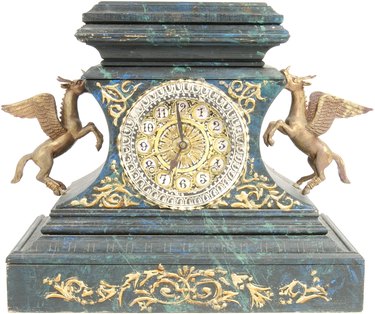
The word mantel clock came into being because the clocks sat on fireplace mantelpieces. It is common to see mantel clocks with matching decorations, such as lions, flowers or columns, on both of its sides. Those mantel clocks were popular in the mid-1800s and beyond, while earlier styles lacked matching decorations. Mantel clocks are similar to bracket clocks, except without a handle on the top. The movements of a clock are the parts that make the hands move and the pendulum swing. Use specific pieces of information to identify mantel clock movements.
Movements
Video of the Day
Antique mantel clocks use mechanical movements, while newer mantel clocks use quartz movements run on a battery. The movements include all moving parts of the clock, except the hands and pendulum. The movements in clocks keep time and have several parts, including a set of connected gears called the train. The clock companies did not make the movement parts, but purchased them from other companies and installed them in the clock bodies.
Video of the Day
Identifying Movements
The clock manufacturer and movement manufacturer are generally two different companies. To determine the movement manufacturer, take the back off the clock to get to the movement inside. Locate numbers or symbols on the back of the movement. Not all clocks have numbers that are easy to see and thus require some hunting with a flashlight. Some mantel clocks have movements that sit on the bottom of the clock, while others are found against the front right behind the face. It might be necessary to remove the weights and pendulum before removing the outer body of the clock if the movement is on the bottom.
Movement Manufacturers
The numbers or symbols on the movement help identify the manufacturer. For example, one of the most common movement manufacturers is Hermle, also known by Welby, Buliva and Talley Industries. Movements made by Hermle have six or seven numbers with a dash in the middle and list the pendulum length if the clock has one. Urgos places a "UW" before numbers, Kieninger places the last two digits of the year of manufacturer at the beginning, and Seth Thomas places an "A" before six numbers with a dash in the middle. Many other companies make movements. It is best to use a antique clock book with a list of manufacturers and their codes.
Worth and Repair
Take antique clocks to a legitimate appraiser to determine its value or check online auction sites to see how much collectors are willing to pay for them. The sale price is often close to the actual worth. There are many antique clock books chock full of helpful information. When replacing clock movements, do not rely on basic knowledge found in a book. Take the clock to a professional. You might damage the clock if you replace the movement by hand unless you have clockwork knowledge. It is not always possible to find movements from the same manufacturer, because not all of them still make parts. The cost is always higher for antique parts.